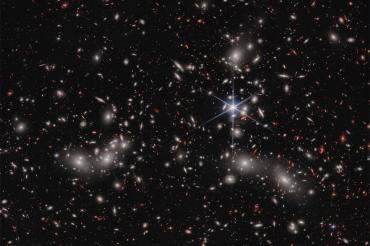Astronomer Lamiya Mowla breaks down 'remarkable' new Webb telescope image

Published: February 17, 2023
Astronomers have revealed the latest deep-field image from NASA’s James Webb Space Telescope, featuring never-before-seen details in a region of space named Pandora’s Cluster.
The new view stitches together four Webb snapshots into one panoramic image, featuring several massive galaxy clusters merging into one megacluster. It also uncovers roughly 50,000 sources of near-infrared light.

Lamiya Mowla
Lamiya Mowla, a post-doctoral researcher at the Dunlap Institute for Astronomy & Astrophysics in the University of Toronto’s Faculty of Arts & Science, is an observational astronomer studying the earliest galaxies in the universe, and a member of the international UNCOVER program (Ultradeep NIRSpec and NIRCam ObserVations before the Epoch of Reionization) that is investigating Pandora’s Cluster.
She also belongs to several other Webb teams, including CANUCS (Canadian NIRISS Unbiased Cluster Survey), which last year discovered the universe’s oldest star clusters in a newly revealed galaxy.
Faculty of Arts & Science writer Josslyn Johnstone recently caught up with Mowla to get her insights on the latest image, which was made publicly available on earlier this week.
How did you feel when you saw this new image and its features?
This is a special milestone for the James Webb Space Telescope. For someone who studies the morphology and structure of galaxies – their shapes, sizes and colours – the Pandora’s Cluster is remarkable because it is showing how much diversity there is in the universe. The unique morphology of each galaxy tells the story of its birth and growth. The high resolution of Webb delivers images of the highest quality and clarity we’ve ever had, and the high sensitivity of the UNCOVER program is allowing us to study this diversity in unprecedented detail.
Only Pandora’s central core has previously been studied in detail by NASA’s Hubble Space Telescope. What’s different about this image?
Webb has captured multiple shots that have been stitched together into one master image, a process called mosaicking – like taking a panoramic picture on your phone. A broader mosaic view like this one allows us to get a bigger picture (literally) of the environment that surrounds the clusters of galaxies, enabling us to study more galaxies and find the rare ones.
Last year you released the largest near-infrared image ever taken by NASA’s Hubble Space Telescope. How does the new imaging power of Webb compare to that of Hubble?
Webb can image at longer wavelengths than Hubble – more in the infrared – beyond what the human eye can see. This is important for observing the early universe since light from distant galaxies gets redder as it travels to us. It means astronomers are better able to see the earliest galaxies that are the farthest away. Webb is also much more sensitive and captures images at a much higher resolution, allowing us to find light from the earliest galaxies.
Pandora’s Cluster is a favourite observational target for astronomers due to the trick of nature known as gravitational lensing. What is this exactly?
We are using Pandora’s Cluster like a giant magnifying glass – the galaxy cluster in the foreground distorts and magnifies much more distant galaxies behind it. By bringing together the imaging power of Webb and this natural magnifying-glass-like effect, we can find objects in the early universe that we wouldn’t otherwise be able to see – even with the power of Webb on its own.
With 50,000 sources and never-before-seen features, it sounds like there is an overwhelming amount of detail to explore in this image. What are you planning to focus on for further study?
Oh yes, it is definitely a lot. I believe that Webb’s first deep field of galaxy cluster SMACS 0723 – the very first Webb image unveiled in July 2022 – has about 10,000 sources, by comparison. It’s similar to the SMACS data, but the UNCOVER program is even more remarkable because it shows three clusters merging together and spectacular features as a result.
I will use this new image to study the growth of galaxies from a very young to an adolescent universe. I am hoping to find the onset of galaxy diversity in galaxy structure – for instance, are galaxies born with very different structures? Or does the variation increase along the way as galaxies get older and have very different paths of life? However, as usual I am more excited about the unexpected!



